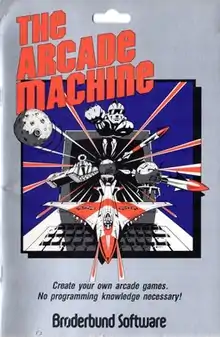| The Arcade Machine | |
|---|---|
 | |
| Publisher(s) | Broderbund |
| Designer(s) | Doug Carlston Chris Jochumson |
| Programmer(s) | Louis Ewens (Atari) |
| Platform(s) | Apple II, Atari 8-bit |
| Release | 1982 |
| Genre(s) | Game creation system, fixed shooter |
The Arcade Machine is a game creation system written by Chris Jochumson and Doug Carlston for the Apple II and published by Broderbund in 1982.[1] Louis Ewens ported it to the Atari 8-bit family.[1] Broderbund ran a contest from January–June 1984 where the best user-created game was awarded a prize of $1,500 in hardware and software.[2] Jochumson also wrote Track Attack for Broderbund.
Gameplay
The game allows players to create alien attacks like those seen in Galaxian. The inbuilt editor allows players to: design/animate enemies, players and explosions; give enemies instructions on moving/firing; drawing backgrounds/title screens, creating sound effects/music, and setting various gameplay rules. Finished games can be saved to a self-booting disk to allow them to run without this program.[3]
Reception
John F. Besnard reviewed the game for Computer Gaming World, and stated that "The product itself provides a tremendous amount of power to the user. Try a few of the demo games supplied on the back of the disk to see the versatility potential of the product."[4]
The New York Times described the game as a "hierophant" due to giving non-programmers the ability to create games; furthermore, the publication suggested that with a bit of aesthetic improvement, The Arcade Machine would "be a game one can play almost forever".[5]
In 1984, InfoWorld deemed it a "fabulous program," and compared it favourably to Pinball Construction Set.[2]
Steve Panak of ANALOG Computing wrote, "The Arcade Machine is not for the weak of stomach, nor for the weak of mind. Complexity is a key word here. However, despite its complexity, the program is surprisingly user-friendly, thanks to excellent documentation." In the conclusion he warned, "Many, many, many hours are needed to create and hone your game to perfection-and that's if you're not a perfectionist."[6]
The game was "a best seller", according to the September 1984 issue of Creative Computing.[7]
References
- 1 2 Hague, James. "The Giant List of Classic Game Programmers".
- 1 2 "InfoWorld". InfoWorld Media Group, Inc. 30 January 1984 – via Google Books.
- ↑ The Arcade Machine Manual (PDF). Broderbund. 1982.
- ↑ Besnard, John F. (Jan–Feb 1983). "The Arcade Machine". Computer Gaming World. Vol. 1, no. 8. pp. 32, 45.
- ↑ "THE IMAGINATIVE PATH TO DESIGNING GAMES". The New York Times. 24 May 1983.
- ↑ Panak, Steve (December 1984). "The Season's Software Sampler". ANALOG Computing (25).
- ↑ Uston, Ken (September 1984). "A family affair; behind the scenes at Broderbund". Creative Computing. 10 (9): 157.
External links
- French review by Jeux
- List of games created using The Arcade Machine
- InfoWorld 30 Jan 1984
- InfoWorld 4 Apr 1983
- InfoWorld 25 Oct 1982
- Kiplinger's Personal Finance